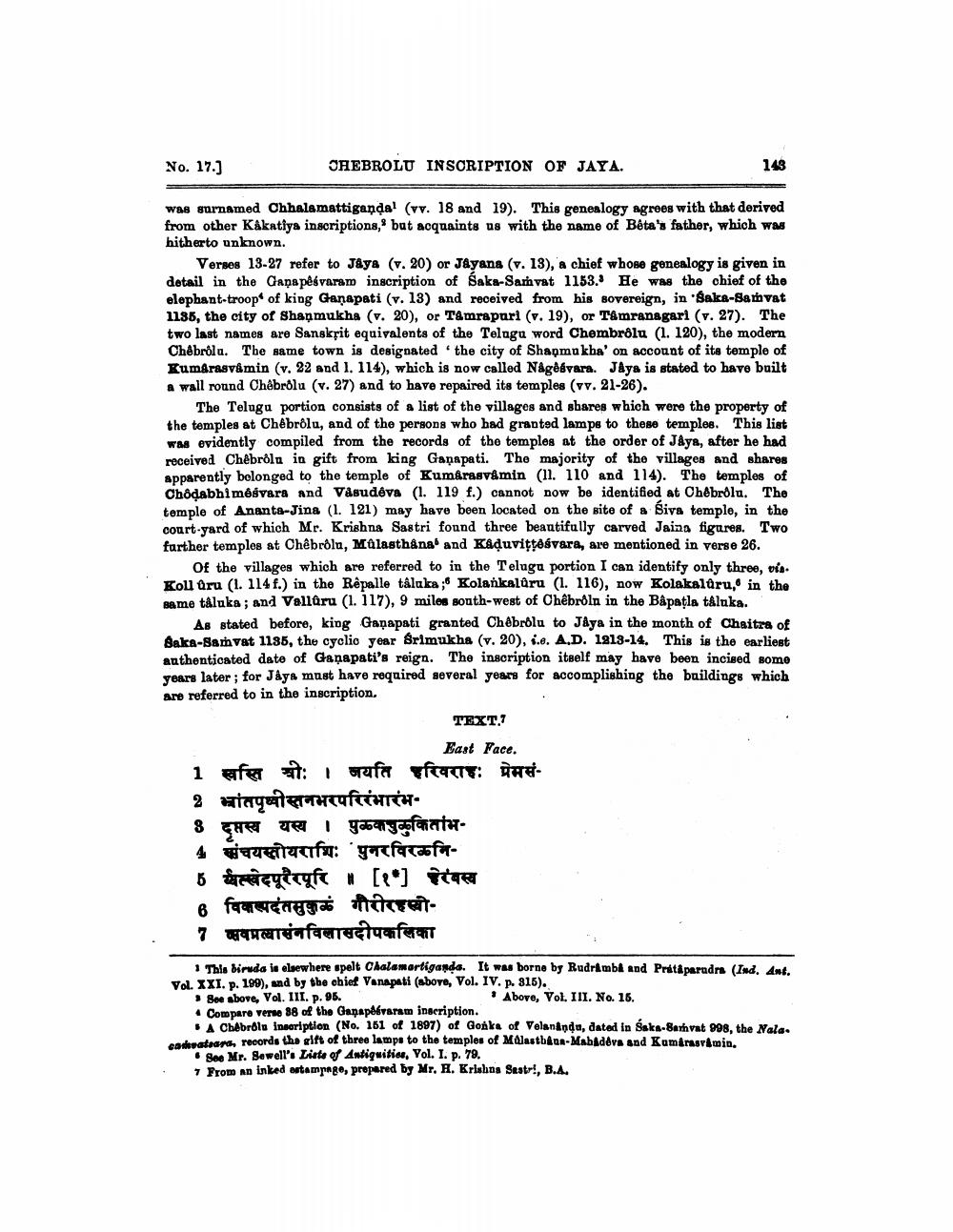________________
No. 17.]
HEBROLU INSCRIPTION OF JAYA.
148
was surnamed Ohhalamattiganda! (vv. 18 and 19). This genealogy agrees with that derived from other Kakatiya inscriptions, but acquaints us with the name of Bêta's father, which was hitherto unknown.
Verses 13-27 refer to Jaya (v. 20) or Jáyana (v. 13), a chief whose genealogy is given in detail in the Canapèsvaram inscription of Saka-Samvat 1153. He was the chief of the elephant-troop of king Ganapati (v. 13) and received from his sovereign, in Sake-Samvat 1136, the city of Shanmukha (v. 20), or Tamrapari (v. 19), or Tamranagari (v. 27). The two last names are Sanskțit equivalents of the Telugu word Chembrôlu (1. 120), the modern Chébróla. The same town is designated the city of Shanmukha' on account of its temple of Kumarasvåmin (v. 22 and 1. 114), which is now called Någèsyara. Jaya is stated to have built a wall round Chêbrolu (v. 27) and to have repaired its temples (vv. 21-26).
The Teluga portion consists of a list of the villages and shares which were the property of the temples at Chêbrôlu, and of the persons who had granted lamps to these temples. This list was evidently compiled from the records of the temples at the order of Jays, after he had received Chêbrola in gift from king Ganapati. The majority of the villages and shares apparently belonged to the temple of Kumfrasvåmin (11. 110 and 114). The temples of Chodabhimêsvara and Vasudeva (1. 119 f.) cannot now be identified at Chébrðla. The temple of Ananta-Jina (1. 121) may have been located on the site of a Siya templo, in the court-yard of which Mr. Krishna Sastri found three beautifully carved Jaina figures. Two farther temples at Chêbrôlu, Mülasthåna and Kaduvitteśvara, are mentioned in verse 26.
Of the villages which are referred to in the Teluga portion I can identify only three, vis. Kol Uru (1. 114 f.) in the Repalle tâlaka ;6 Kolankalûru (1. 116), now Kolakalaru, in the same tAluka; and Vallgru (1. 117), 9 miles south-west of Chêbröln in the Bapatla taluka.
As stated before, king Ganapati granted Chêbrölu to Jaya in the month of Chaitra of Saka-Samvat 1185, the cyclic year Srimukha (v. 20), i.e. A.D. 1213-14. This is the earliest authenticated date of Ganapati's reign. The inscription itself may have been incised some years later; for Jaya must have required several years for accomplishing the buildings which are referred to in the inscription.
TEXT.7
East Face. i afer #t: I refer fare: DHE 2 भांतपृथ्वीस्तनभरपरिरंभारंभ. 3 दप्तस्य यस्य । पुळकचुकुकिताभ4 qua f : 'yonefacao fato 8 PANCY Tfc # [l] fiae 8 विकल्पदंतसुकुळं गौरीरहस्यो7 सवप्रत्यासंनविलासदीपकलिका
1 Thla diruda i elsewhere spelt Chalamartiganda. It was borne by Rudramba and Pratáparadra (Ind. Ant. Vol. XXI. p. 199), and by the obiet Vanapati (above, Vol. IV. p. 815). » Soe above, Vol. III. p. 95.
. Above, Vol. III. No. 16. • Compare verne 88 of the Ganapééraram inscription.
Chabrolo ineoription (No. 161 of 1897) of Gorka of Velankoda, dated in Saka Barnvat 998, the Nala. retear, records the gift of three lamps to the temples of Molastb&ua-Mahaders and Kamerasimin,
See Mr. Sewell's Liste of Antiquities, Vol. I. p. 79. From an inked stampago, prepared by Mr. H. Krishna Sastr!, B.A.




